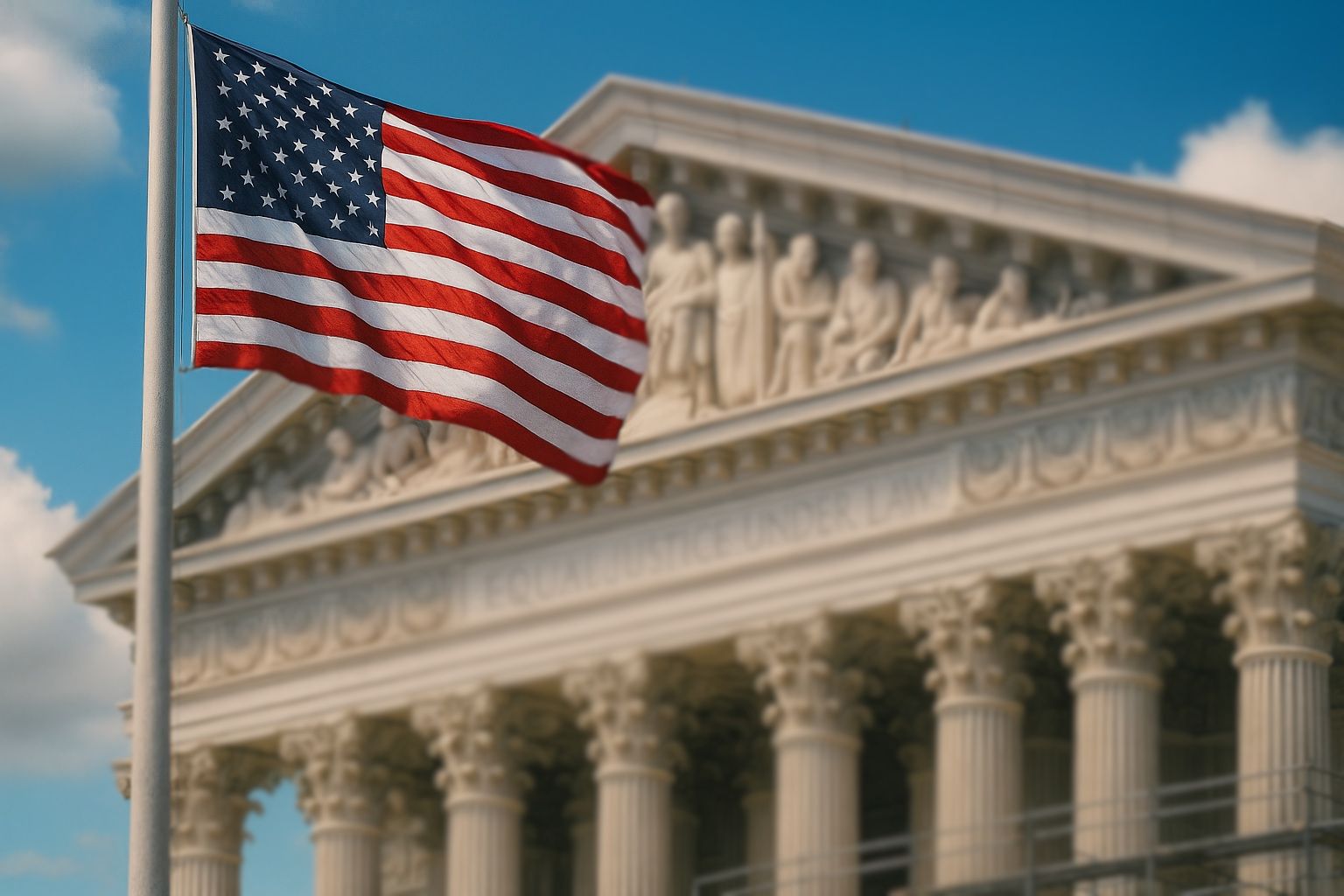- Historic Case: On November 5, 2025, the U.S. Supreme Court heard a landmark case testing whether President Donald Trump overstepped his authority by imposing sweeping global tariffs under a 1977 emergency-powers law [1] [2]. The case consolidates challenges from 12 states (led by Oregon) and numerous businesses, which argue that only Congress can levy import taxes [3] [4]. Lower courts agreed and struck down Trump’s tariffs, setting the stage for this high-stakes showdown [5] [6].
- Tariffs in Question: Trump’s “emergency” tariffs – ranging from 10% to over 100% on a vast range of imports – were enacted by declaring national emergencies (citing issues like drug trafficking and trade imbalances) and invoking the International Emergency Economic Powers Act (IEEPA) [7] [8]. These tariffs hit almost every country, far beyond traditional trade sanctions, and have upended supply chains for industries from tech to textiles. Small-business owners testify the tariffs have “wiped out profits” and crippled hiring, since many products simply can’t be sourced domestically [9] [10].
- Justices Skeptical: At oral arguments, justices across the ideological spectrum grilled the government’s lawyer, Solicitor General D. John Sauer. Sauer insisted the tariffs are “regulatory” measures, not taxes, claiming any revenue is “incidental” [11]. The Court’s response was notably skeptical. Justice Sonia Sotomayor shot back that “tariffs are not taxes” is a fiction – “that’s exactly what they are. They’re generating money from American citizens” [12]. Chief Justice John Roberts noted that hitting Americans with import duties “has always been the core power of Congress,” implying Trump’s actions usurp the legislature [13]. Even Trump-appointed conservatives raised alarms: Justice Amy Coney Barrett pressed for any historical precedent where “regulate imports” was understood to confer tariff power (none was given) [14], and Justice Neil Gorsuch delivered a combative broadside about unchecked delegation – “What would prohibit Congress from abdicating all responsibility… and just hand it all off to the President?” [15].
- Presidential Power vs. Law: The Trump administration argues IEEPA implicitly empowers the President to “regulate” foreign commerce in emergencies, even via tariffs [16]. Trump insists these tariffs are vital for national security and trade fairness: “If we don’t have tariffs, we don’t have national security… other countries…took advantage of us” he said, defending his actions [17]. However, the law’s text notably never mentions tariffs or taxes, and Congress’s constitutional authority over duties is explicit [18] [19]. Several justices invoked the “major questions doctrine,” suggesting that such a vast economic move – affecting billions in trade – requires clear congressional authorization [20] [21]. Legal experts call the case “staggeringly important… from an economic perspective and a separation of powers perspective” [22], as it will define the limits of executive economic power.
- Economic Stakes Are High: Trump’s tariffs have raised consumer prices and business costs, contributing to inflation and uncertainty [23]. Critics label them “directly stagflationary” and harmful to growth [24]. The federal government, meanwhile, has raked in tariff revenues at an unprecedented scale – over $88 billion in 2025 alone [25] – effectively a hefty tax on U.S. importers. If the Court invalidates the tariffs, the government could owe tens of billions in refunds to companies that paid these duties [26] [27], a complex process that businesses are already bracing for. The Tax Foundation and others estimate Trump’s tariff program, if upheld, would generate $1–2.8 trillion over the next decade [28] [29] but at the cost of higher prices (over $1,000 per U.S. household annually, rising to $1,300) and hundreds of thousands of lost jobs due to trade retaliation and inefficiencies [30].
- Market Reaction: Financial markets and corporations are watching closely. Trump’s hardline trade stance has been a double-edged sword for investors – introducing volatility but also prompting hopes of eventual deals. In fact, U.S. stock indexes soared to record highs in late October on optimism that trade tensions were easing, after Trump signaled readiness to scale back some China tariffs amid negotiations [31]. (Just days before the hearing, Trump met China’s President Xi and agreed to halve tariffs on fentanyl-related imports in exchange for China’s crackdown on the opioid trade [32] [33].) By Nov. 5, Wall Street appeared cautiously optimistic: companies reliant on imported inputs (e.g. electronics, apparel) stand to benefit if tariffs are struck down, while U.S. steel and other protected industries could face new competition. Major indices ticked up during the arguments, reflecting hopes for clarity; as one analyst put it, the market had treated tariffs as a “solved problem” – an assumption now being tested by the Court’s looming decision.
- Potential Outcomes: A ruling is expected within weeks or months (the case was fast-tracked, though some predict a decision by mid-2026) [34]. If the Court sides with Trump, it would cement a dramatic expansion of presidential trade power – effectively giving the White House a green light to impose or hike tariffs unilaterally whenever an “emergency” is declared [35]. Such a precedent would be “a new world order” for economic governance, one scholar said, upending the constitutional balance for taxing and spending [36]. It would also preserve a key Trump policy tool (which he credits with boosting manufacturing and which he calls “one of the most important cases in history” for the country [37]), though at the expense of higher costs to consumers (over $1,700 per family this year in price increases, by one estimate [38]) and strained relations with trading partners. If the Court rules against Trump, it will rein in executive authority and reaffirm that Congress alone controls tariffs and taxes [39] [40]. All of Trump’s IEEPA-based tariffs would likely be invalidated, providing immediate relief to importers and consumers. The White House warns this outcome could “expose our nation” to economic harm – claiming that losing tariff powers would invite foreign trade abuses and “thrust America back to the brink of economic catastrophe” [41] – but many economists counter that removing these import taxes would lower inflation and help U.S. growth more than it hurts. Importantly, even a loss for Trump won’t lift all trade barriers: tariffs imposed under other laws (like steel/aluminum tariffs under Section 232 national-security authority) would remain in place, though a defeat would greatly constrain any future president from using catch-all emergency powers to tax imports [42] [43].
- Broader Context: The tariff saga highlights a tension in the Supreme Court’s conservative majority. The justices have been deferential to executive power in foreign affairs and national security, yet they’ve also aggressively enforced limits (via the major-questions doctrine) on unilateral domestic policies without Congress’s clear consent [44]. This case straddles those lines: tariffs touch foreign trade (normally a realm of executive flexibility) but also domestic economics and taxation. As constitutional law expert Jonathan Adler observed, “If [the justices] see it as a foreign affairs case, the administration wins. If … as a textual interpretation case, they lose.” [45] In other words, the outcome may hinge on whether the Court views Trump’s tariffs more as a national-security measure or as an improper tax grab.
- What’s Next: For now, Trump’s tariffs remain in effect pending the Court’s decision [46]. Businesses are not waiting idly: many are compiling records and preparing refund claims, should the Court invalidate the duties [47]. Trade policy watchers also note that if Trump’s IEEPA tariffs fall, the administration might scramble to reimpose some duties under other statutes (albeit more limited ones), or appeal to Congress for new authority. In the political arena, the case has fueled debate over the proper scope of emergency powers. Democrats (and some Republicans from import-dependent states) argue Trump abused a law meant for true crises, while Trump and his allies insist he needed to get tough on trading partners who “for years…took advantage of us” [48]. Internationally, U.S. trading partners are closely monitoring the verdict: a win for Trump could prolong trade frictions, whereas a loss might signal a U.S. pivot back toward more predictable, law-based trade practices.
In sum, the Supreme Court appears poised to make a definitive ruling on Trump’s tariff gambit – one that will either vindicate his bold use of emergency power or slam the brakes on it. The stakes are enormous: billions of dollars, the balance of economic power between Congress and the President, and the future course of U.S. trade policy all hang in the balance. As Hofstra law professor James Sample noted, this is “a staggeringly important case” that could reshape the economy and constitutional order for years to come [49]. Both Wall Street and Main Street await the outcome, bracing for a ruling that could reverberate from the factory floor to global markets. Whatever the justices decide, the aftermath will be a defining moment for how America makes its trade rules – through the President’s pen or by act of Congress – in the turbulent era of tariff wars and economic nationalism.
Sources:
- Wall Street Journal – Live Coverage, Supreme Court Tariffs Case (Nov. 5, 2025) [50] [51]
- The New York Times – Live Updates: Trump Tariffs at the Supreme Court (Nov. 5, 2025) [52] [53]
- CNN Politics – Live News: Supreme Court & Trump Tariffs (Nov. 5, 2025) [54] [55]
- Oregon Public Broadcasting – “Oregon argues against Trump tariffs in case before US Supreme Court” [56] [57]
- Reuters – Trump says he won’t attend Supreme Court tariff hearing (Nov. 3, 2025) [58] [59]
- Fox Business – “Supreme Court weighs Trump’s tariff authority under emergency law” [60] [61]
- ABC News – “Supreme Court hears Trump tariffs case, justices skeptical of president’s power” [62] [63]
- Reuters – Trump shaves China tariffs in deal with Xi on fentanyl (Oct. 30, 2025) [64] [65]
- Nasdaq/Barchart – Stock Indexes Soar as Global Trade Tensions Ease (Oct. 29, 2025) [66]
References
1. abcnews.go.com, 2. abcnews.go.com, 3. www.opb.org, 4. abcnews.go.com, 5. www.opb.org, 6. abcnews.go.com, 7. abcnews.go.com, 8. abcnews.go.com, 9. abcnews.go.com, 10. abcnews.go.com, 11. abcnews.go.com, 12. www.washingtonpost.com, 13. abcnews.go.com, 14. abcnews.go.com, 15. www.washingtonpost.com, 16. abcnews.go.com, 17. www.reuters.com, 18. abcnews.go.com, 19. www.washingtonpost.com, 20. www.washingtonpost.com, 21. www.washingtonpost.com, 22. abcnews.go.com, 23. www.foxbusiness.com, 24. www.foxbusiness.com, 25. www.foxbusiness.com, 26. www.foxbusiness.com, 27. abcnews.go.com, 28. www.foxbusiness.com, 29. abcnews.go.com, 30. www.foxbusiness.com, 31. www.nasdaq.com, 32. www.reuters.com, 33. www.reuters.com, 34. abcnews.go.com, 35. abcnews.go.com, 36. abcnews.go.com, 37. abcnews.go.com, 38. abcnews.go.com, 39. abcnews.go.com, 40. abcnews.go.com, 41. www.opb.org, 42. abcnews.go.com, 43. abcnews.go.com, 44. abcnews.go.com, 45. abcnews.go.com, 46. abcnews.go.com, 47. www.foxbusiness.com, 48. www.reuters.com, 49. abcnews.go.com, 50. www.washingtonpost.com, 51. www.washingtonpost.com, 52. www.washingtonpost.com, 53. www.washingtonpost.com, 54. www.washingtonpost.com, 55. www.washingtonpost.com, 56. www.opb.org, 57. www.opb.org, 58. www.reuters.com, 59. www.reuters.com, 60. www.foxbusiness.com, 61. www.foxbusiness.com, 62. abcnews.go.com, 63. abcnews.go.com, 64. www.reuters.com, 65. www.reuters.com, 66. www.nasdaq.com





